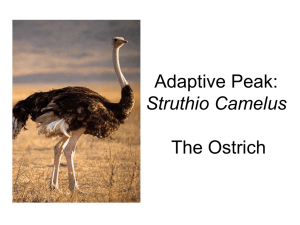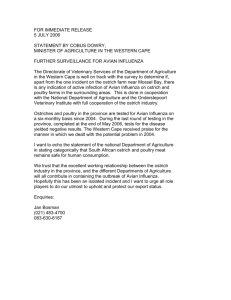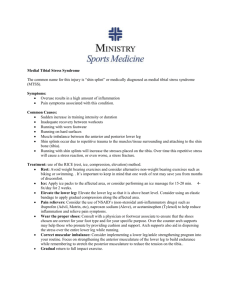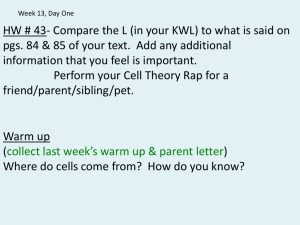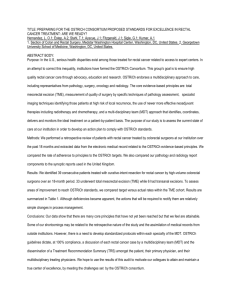Lesson Plan: Struthiomimus speed (Word doc)
advertisement
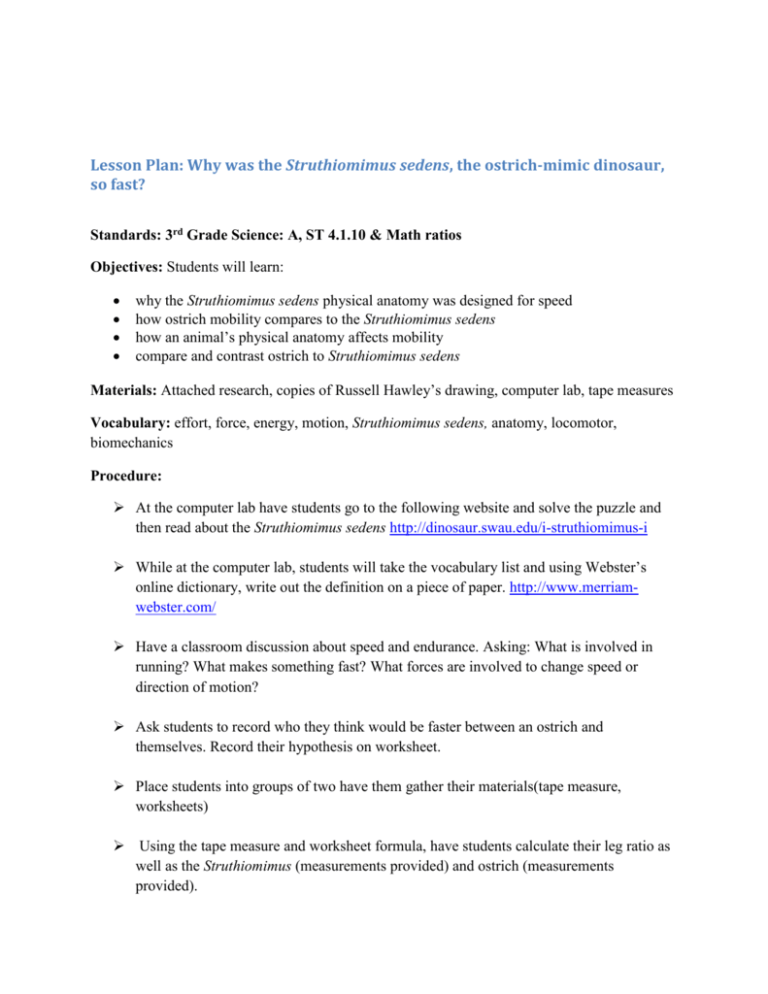
Lesson Plan: Why was the Struthiomimus sedens, the ostrich-mimic dinosaur, so fast? Standards: 3rd Grade Science: A, ST 4.1.10 & Math ratios Objectives: Students will learn: why the Struthiomimus sedens physical anatomy was designed for speed how ostrich mobility compares to the Struthiomimus sedens how an animal’s physical anatomy affects mobility compare and contrast ostrich to Struthiomimus sedens Materials: Attached research, copies of Russell Hawley’s drawing, computer lab, tape measures Vocabulary: effort, force, energy, motion, Struthiomimus sedens, anatomy, locomotor, biomechanics Procedure: At the computer lab have students go to the following website and solve the puzzle and then read about the Struthiomimus sedens http://dinosaur.swau.edu/i-struthiomimus-i While at the computer lab, students will take the vocabulary list and using Webster’s online dictionary, write out the definition on a piece of paper. http://www.merriamwebster.com/ Have a classroom discussion about speed and endurance. Asking: What is involved in running? What makes something fast? What forces are involved to change speed or direction of motion? Ask students to record who they think would be faster between an ostrich and themselves. Record their hypothesis on worksheet. Place students into groups of two have them gather their materials(tape measure, worksheets) Using the tape measure and worksheet formula, have students calculate their leg ratio as well as the Struthiomimus (measurements provided) and ostrich (measurements provided). Record their finding on their worksheet. Based on their findings have them discuss in pairs who would be faster between themselves and between ostrich and Struthiomimus and why. Have students come together as a whole and have a final discussion about their findings, determine if their hypotheses were correct and share the background information about ostrich locomotion which is very similar to the Struthiomimus. Enrichment: Take students to the Tate Geological Museum to see the Struthiomimus seden cast. Background Information: Hypotheses as to why the ostrich (and Struthiomimus) is/was so fast: “Ostrich locomotor system transmits power to the ground with a high degree of efficiency, maximizing energetic output (speed and endurance) while minimizing energy demands (muscular and metabolic work). In a running animal, higher speeds are achieved by increasing both the length and frequency of steps. Longer legs can swing further, and if the leg’s muscle mass is located proximally (close to the body), the leg can then swing faster, in the same way that moving the adjustable weight of a metronome closer to the pivot increases the tempo” (Schaller, November 2011). See link for more information: http://www.scienceinschool.org/2011/issue21/ostrich Ostriches have: 1. Light limbs which concentrate the leg muscle mass closer to the hip joint 2. Long leg length with the tibia longer than the femur 3. Claws act like spikes penetrating ground for maximum speed with minimal energy 4. Less sideway motion maximizing energy forward (unlike energy-consuming muscles and their tendons, ligaments can act as a joint corset limiting sideway motion without consuming energy. (flexibility and speed at odds with each other) See attached illustration of the Struthiomimus sedens drawn by Russell Hawley of the Tate Geological Museum A wide range of joint motion allows humans to climb trees or ballet dance, but this flexibility has a cost. When we run, muscle power is used for propulsion but also to prevent sideways joint movement, thereby increasing our energy requirements over a given distance. Comparison of leg segment lengths and muscle mass distribution of fast-running, grounddwelling bird species. Of all cursorial birds, the ostrich possesses the longest legs relative to its size and has the longest step length when running: 5 m. In addition, to a greater degree than other bird species, it has the majority of its leg musculature located very high on the thigh bone and hip, whereas the lower swinging elements of its leg are comparatively light, moved by long, mass-reducing tendons. This arrangement optimizes the ostrich leg for high-velocity locomotion, giving it both a long step length and a high step frequency. Other bird speeds: Struthiomimus estimated speed 30-50 mph Wild turkey 25 mph Ostrich 43 mph Human fastest recorded 27 mph -average speed 12mph Name_________________ Leg Measurement and Ratios Name all that is involved in running. ______________________________________________________________________________ ______________________________________________________________________________ Using the following instructions find out your leg measurements and your femur to tibia ratio. Measure your femur and record measurement ________________. This number will be represented as the letter (F). Students will measure their tibia and record measurement _____________. This number will be represented as the letter (T). Students will add the femur and tibia to get the total length of their leg______. This number will be represented as the letter (L). Divide F by L and multiply by 100, giving students femur to leg ratio ________ .This number will be presented by (FL). Subtract the (FL) figure from 100. This will give you your tibia to leg ratio _________. This number will be represented as the letter (TL). F:T is the femur to tibia ration Run the above formula for the Tate’s Struthiomimus sedens, ostrich mimic dinosaur to compare leg ratios. Struthiomimus: Femur 61 cm Ostrich Femur without cartilage 28 cm Struthiomimus: Tibia 67 cm Ostrich Foot (2 toes) reduced number of toes is an adaptation that appears to aid in running. Ostrich Tibia without cartilage 49 cm Struthiomimus Foot (3 toes)
